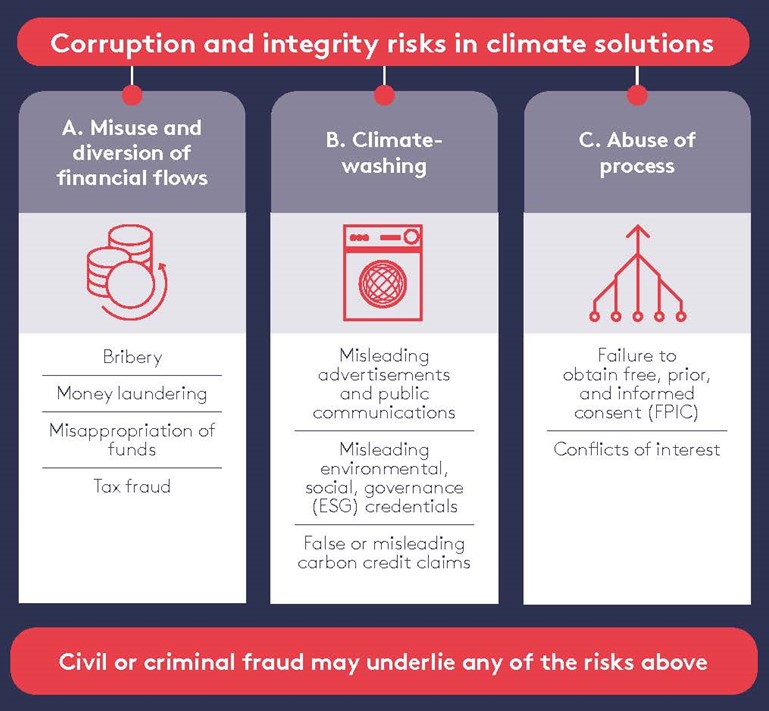Corruption and integrity risks in climate solutions: an emerging global challenge

Download
Corruption and poor integrity in the implementation of policies and projects that aim to combat climate change pose significant risk to the delivery of these ‘climate solutions’. Despite an increasing awareness of corruption and integrity risks, and their role in delaying climate action over the past few decades, conventional anti-corruption actors are yet to take significant action to ensure the integrity of climate solutions.
This report aims to contribute to an improved understanding of the emerging corruption and integrity risks threatening the low-carbon transition today, and provide recommendations to a range of stakeholders on how to tackle them.
Key messages
- The authors identify three main categories of risk – see Figure 1 – and they make recommendations in each of these areas for stakeholders including regulators and enforcement agencies, lawyers, legislators, consultants to the private sector and companies.
- Misuse and diversion of financial flows is the risk that the trillions of dollars in public and private investment are required for the transition to a sustainable economy is channelled towards private pockets, high-emitting activities operating under the guise of ‘green’ initiatives, or criminal activity. This encompasses bribery, money laundering, misappropriation of funds and tax fraud.
- Climate-washing is defined as acts that mislead investors, consumers or the general public regarding climate-related impacts or outcomes, or overstate an actor’s climate performance. Climate-washing can create a false sense of confidence around the implementation of climate action, potentially leading to complacency and delaying effective solutions. Misleading advertisements and public communications, misleading environmental, social, governance (ESG) credentials and false and misleading carbon credit claims fall into this category.
- Abuse of process takes place when actors dishonestly abuse legitimate processes as part of the implementation of climate solutions. Key risks that result include: failure to obtain ‘free prior and informed consent’ (FPIC) from Indigenous and local communities that are impacted by projects; and conflicts of interests.
- Robust governance structures are needed to ensure that climate solutions continue to be delivered, and that this happens in a credible and efficient manner. The emerging challenge of corruption and integrity risks requires supportive engagement from and coordination between a broad range of actors.
- Despite the prevalence of anti-corruption laws, enforcement efforts do not yet adequately target the manifestations of corruption in the context of climate solutions. Fortunately, many of the risks identified in this report can be addressed through existing legal frameworks, such as criminal and civil law. Raising awareness of practices that illegally or dishonestly weaken the implementation of climate solutions, such as through issuing more targeted guidance, is a way in which these issues can be identified at an earlier stage.
- Private sector actors can look to the broader anti-bribery arena, where similar risk factors to those that affect climate solutions exist, and where corresponding compliance programmes are comparatively well established, particularly in larger companies.
- At the national level, it is fundamentally the role of public authorities to monitor corruption and integrity risks, respond to complaints, provide guidance on managing risks and, if necessary, take robust enforcement action against those that continue to engage in corrupt behaviours.
Figure 1. Corruption and integrity risks in climate solutions


